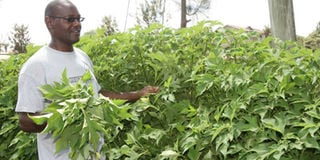For small-scale organic farming, use tithonia plant

Robert Ngugi picks tithonia leaves in his farm in Wendani which he uses to prepare manure. The manure provides organic elements; N, P and K in amounts excess to what mineral fertiliser provides. PHOTO | CAROLINE CHEBET | NMG
What you need to know:
- Phytotherapeutic chemical composition of this shrub ranges from essential oils (penene, caryophyllene and germacrene D) and phenolic compounds (tannins and flavonoids).
- The organic fertiliser is mined from mineral deposits from synthetic compounds.
- This shrub can naturally exist as a weed on farms or planted using either cuttings or the seeds.
- The fertiliser can be used in the growing of sukuma wiki, sorghum, cowpeas, beans, maize and tomatoes.
Tithonia or wild sunflower (Tithonia diversifolia) is a soft succulent shrub that grows 1-3 metres high with alternate lobed leaves whose margins are toothed with a sharp apex.
Its flowers resemble those of sunflower, however, the seeds are smaller. In Kenya, this shrub which was introduced as an ornamental plant from Mexico is found in Western, Coast, Central and Rift Valley.
The leaves of this shrub are bitter. Communities have named them differently. The Kikuyu’s call it ‘maruru’, Luos ‘mauamakech’, Luhyas ‘amaua amalulu’ and Kisiis ‘amaua amaroro’.
Phytotherapeutic chemical composition of this shrub ranges from essential oils (penene, caryophyllene and germacrene D) and phenolic compounds (tannins and flavonoids).
These compounds have been linked to the therapeutic properties of (T. diversifolia). For example: tagitinin, a compound from T. diversifolia leaves, inhibits the growth of E.coli, S. aureas. T. diversifolia has been used to lower the risks of gastrointestinal infections, skin diseases, urinary tract infection, diabetes, malaria, diarrhoea, constipation, sore throat, liver pain, stomachache and free radical scavenging.
Use of tithonia plant as a pesticide and organic fertiliser
The organic fertiliser is mined from mineral deposits from synthetic compounds and contains N, P and K. Use of tithonia helps curb reliance on chemical fertilisers that have impoverished soils.
Propagation of tithonia
This shrub can naturally exist as a weed on farms or planted using either cuttings or the seeds. When using seeds, they are scattered in narrow furrows and covered with a thin layer of sand. When using cuttings, 20cm stems with two nodes below the ground and three nodes above the ground are planted at an angle of 450.
Chemical composition of tithonia
Tithonia green manure has proved to be a reliable source of Nitrogen (N), potassium (K) and phosphorous (P) for plant growth.
It is, therefore, used as an organic fertiliser. The percentage composition of the major organic mineral element that are abundantly found in tithonia plant include: Nitrogen (3.2–5.5%), potassium (2.3–5.5%), phosphorous (0.2–0.5%), calcium (1.8–2.0%) and magnesium (0.3–0.4%).
Taking an average mineral composition of the 3.5% N, 0.37% P, 4.1% K, 2–4 tonnes of tithonia can be used to supply N (70–140kg N/ha) and K (80–165kg K/ha).
This shows that green manure from tithonia plant has the potential to replace the inorganic mineral fertiliser because it can supply the essential minerals in excess of what the mineral fertiliser provides.
Organic fertiliser from tithonia can be in two forms: liquid fertiliser or green manure.
Liquid fertiliser
This is made by expressing the sap from tithonia leaves and twigs after crushing them. Mineral elements found in the plant (N and P) dissolve in water. To make the fertiliser, first:
Collect the leaves and twigs of fresh tithonia plant from the farm boundaries if not planted;
Cut them into smaller pieces to hasten decomposition;
Transfer the materials into a plastic container and fill it with water and cover it loosely;
Put the container plus its contents under the shade for at least 21 days;
When the content starts forming black mass, filter the content through a gunny bag and dilute the solution with water in a ratio 1:3;
Top dress each crop with 100ml of the fertiliser.
Green manure
Tithonia green manure can be applied to plants in different forms: cut tithonia leaves and twigs into small pieces and apply it in the planting holes or apply them on the surface and cover it with a thin layer of the soil.
For better results, you can apply the manure a week before planting. It can also be applied continuously to the crops during the crop growing season.
The fertiliser can be used in the growing of sukuma wiki, sorghum, cowpeas, beans, maize and tomatoes.
Advantages of using tithonia liquid fertiliser
It has a high concentration of dissolved nutrients, which are readily available for the plant unlike in the mineral fertiliser where these nutrients are bound in fertiliser filler materials.
Presence of microorganisms in this fertiliser breaks down the organic matter in the soil enhancing the activity of the soil, and increasing nutrient availability to the plant.
T. diversiforlia acts as an insect repellent, hence controls insects when used to make the liquid fertiliser.
Provides organic elements; N, P and K in amount excess to what mineral fertiliser provides
Other benefits of tithonia
Used in demarcation of different plots on the farm.
Can be used as fodder.
Improves soil aeration.
Used as a contour strip and live fence.
Biological pesticide
Harvest leaves and twigs and crush them in a mortar and pestle. Add water to the Tithonia diversiforlia crushed paste and sieve to get a clear liquid.
Five litres of water are used to dilute 17kg of concentrated T. diversiforlia paste to form a clear liquid pesticide. This pesticide has been use in controlling pests in vegetables.
The advantage is that it is effective, cuts the cost of production and the vegetables are free from chemicals.
The writer is based at the Department of Dairy, Food Science and Technology, Egerton University.




